Content [show]
Achatina is a gastropod molluscs native to hot climates where they are considered voracious pests. In European countries, Achatina is kept at home as an exotic pet.
At home, the African snail grows up to 25 cm in length, and a large pet means happy and healthy.
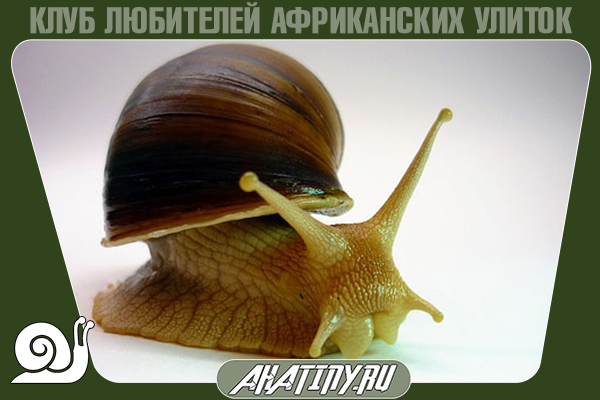
10 tips on how to grow an African snail
1 Buy babies, only at a pet store or from trusted breeders.
Firstly, it is a guarantee that you will get exactly the type of Achatina that you need. Secondly, you can always ask the breeder for help or advice.
2 So that your snail grows by leaps and bounds. Get her a spacious terrarium, food container. The volume of the container in which the Achatina will live should be 5 times the size of an adult animal. This means at least 20 liters. 3 Take care of proper ventilation in the clam dwelling. Punch 4-5 holes on one side of the cage or container, 5 cm below the lid. And the same number of holes on the other wall, only near the ground. Thus, the air will constantly circulate.
Remember to equip the terrarium with a lid so that your pet does not start an independent journey through your apartment.
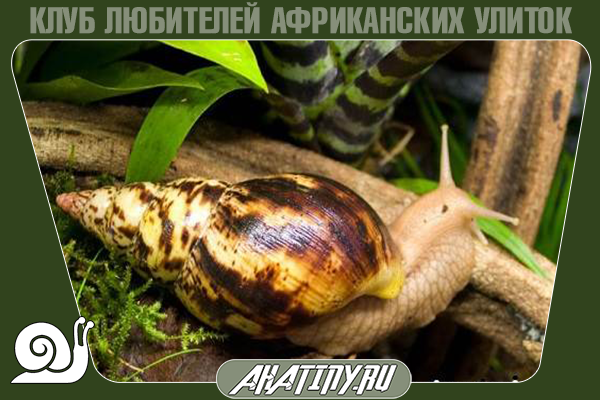
4 Achatina is a land mollusk, therefore, for a comfortable stay at home, it needs soil. How to choose it correctly.
- Firstly, snails sleep in the ground, lay eggs in it.
- Secondly, they eat it, so be careful when choosing a soil. Do not use fertilized soil, sand, sawdust, clay and stones.
- Third, the soil helps maintain constant moisture in the terrarium. Therefore, give preference to coconut substrate, moss, leaf litter, peat and clean soil.
5 It is important to maintain optimum temperature and humidity in the enclosure at all times. Each type of Achatina has its own temperature and humidity. Most often, the temperature ranges from 26 to 29 degrees, and the humidity from 65% to 80%. Look at the behavior of your pet, if it has become inactive, eats poorly, feel free to increase the temperature by 1-2 degrees. If constantly sitting on the wall or ceiling of the terrarium, then it is too humid, reduce the number of irrigations. Many snail breeders specially put some moss in the terrarium, it serves as a kind of indicator of moisture. Green - enough moisture, dries - spray the terrarium more often.

6 The daily Achatina menu should be varied and balanced. The lion's share of her diet is made up of vegetables and fruits, greens.
Fresh vegetables
- pumpkin;
- cabbage;
- lettuce leaves;
- tomatoes;
- zucchini;
- carrot;
- cucumbers;
- Bell pepper.
Fresh fruits
- pears;
- Strawberry;
- apples;
- watermelon;
- melon;
- apricot;
- bananas.
Greens
- Dill;
- parsley;
- birch leaves;
- oak leaves;
- nettle;
- dandelion;
- plantain.
Do not put food directly on the ground, as uneaten remains of vegetables and fruits in a humid environment quickly deteriorate and mold, gnats and an unpleasant odor appear. How to effectively deal with midges in the terrarium.
Remove leftover food daily to help prevent odors, mold, midges and parasites in the enclosure.
7 For the construction of a beautiful shell, the proper development of all organs and systems, the snail needs calcium.
Sources of calcium
- eggshell;
- sepia;
- food chalk;
- shell rock;
- blue clay.
The most important thing is that calcium is always available to her.
These sources of calcium can be offered all at once, you can alternate. Sepia and edible chalk can be put in a single piece in the terrarium, and the shell rock, eggshells give Achatina only in ground form. Sprinkle food with a calcium mixture, put it in a small pile on the ground - the snail will find it and eat it.
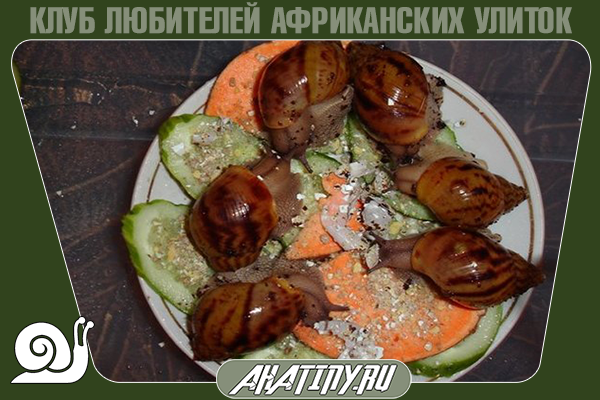
8 Achatina needs protein foods. Its value is important for the health and development of the snail. Protein can be divided into plant and animal proteins. Top dressing recipes for fast snail growth.
Sources of vegetable protein
- oatmeal;
- buckwheat;
- Wheat groats;
- bran;
- corn grits;
- boiled legumes;
- mushrooms;
- nuts.
Sources of animal protein
- gammarus;
- daphnia;
- food for fish;
- bone flour;
- dairy products.
You can grind the cereals in a coffee grinder, put them in a jar, and put 1-2 tablespoons daily in a separate bowl or on lettuce and vegetables. Vegetable protein is not as hazardous to shellfish health as animal protein.
The death of the snail is caused by salt, sugar, smoked meats, spicy foods, alcohol, potatoes, onions, citrus fruits and semolina.
You need to be careful with animal protein.
Achatins love it very much, sometimes they refuse to eat other food, so it should be given 2-3 times a week, 1/2 spoonful in order to avoid protein poisoning. And it happens due to the lack of control eating a large amount of animal protein. Why is gammarus dangerous for Achatina? The body of the mollusk swells, secretes a lot of white mucus, and if proper measures are not taken, Achatina dies.
9 Remove food scraps and waste daily. The smell of a snail and its poop do not have, so the source of an unpleasant smell can be a simple lack of hygiene. Try to prevent food from rotting, waterlogging, and flies.
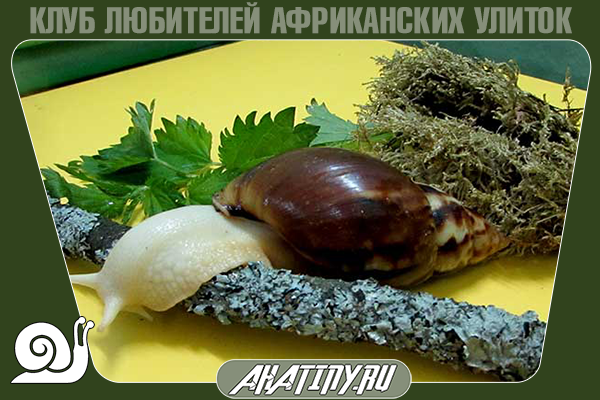
Wash the terrarium once a week, rinse the soil and add a little fresh. Replace worn-out driftwood and moss as needed.
Bathe your pet in warm water once a week. Gently wiping the sink and delicate body with a soft brush or cloth.
When bathing, be careful not to drown or "cook" Achatina under hot water.
After bathing, do not forget to anoint the snail shell with olive or other natural oil. If your snail is very smeared, then you can bathe it more than once a week or put a shallow container of water in the terrarium.
10 The snail is prone to illness and injury. If the above rules are not followed, all your desire to grow a healthy snail can be nullified. If Achatina is bad in the conditions you created, she goes into hibernation until better times. Hibernation for a tropical snail is not typical and is a necessary measure. During suspended animation, the mollusk consumes water reserves and its own reserves.
During hibernation, the animal loses up to 60% of its own weight, and young snails die more often.
Therefore, try to create at home conditions as close as possible to its natural environment. And your two-horned pet will delight you for many years.
Video about the Achatina snail
If you have more information on the successful cultivation of Achatina at home, leave your comment.
How to grow the Achatina snail so that it reaches gigantic proportions? This question is asked by everyone who dreams of making an even more unique exotic out of an unusual pet. There are no secrets: it is enough to provide the mollusk with conditions as close to natural as possible and improve them.
To what size does the Achatina snail grow?
Achatina fulica translated from Latin means the giant Achatina snail. It is truly considered the largest mollusk. Under natural conditions, it grows up to 30 cm, and in weight it reaches 400 grams.
At home, the shell of the animal can grow up to 25 cm, and the body - up to 29-31 cm. The sizes are directly related to the conditions of detention and the fact of mating.
See also: What was the biggest Achatina in history?
Influence of terrarium volume
In order for the Achatina snail to grow huge, and quickly, it is worth buying a spacious house for it. This could be a terrarium, an aquarium, or a large food container. The main condition is that the walls of the room must be transparent, and the ulitar itself must be well ventilated. Its volume must exceed the size of the snail at least five times. Accordingly, the displacement should start from 20 liters or more. In cramped housing, the snail will slow down in development, or even stop growing altogether.
Read more about choosing the right house for a snail in our article
As for ventilation, it can be provided by 4-5 holes on one of the four sides of the housing. You need to drill holes 5-6 cm below the roof. On the opposite side, the procedure is repeated, only this time 5-6 cm above the ground level. This will ensure constant air circulation. And the terrarium itself is closed with a lid. Otherwise, the pet will be able to crawl out of it and begin an unauthorized journey around the apartment.
See also: How much does it cost to keep Achatina snails?
It is important for development to maintain a balance between temperature and humidity. There are several types of Achatina. For each, these values are individual. But the average temperature should not be below 26 degrees and above 29-30. Humidity ranges from 66 to 85%.
An attentive breeder will definitely pay attention to the behavior of the snail. If she has become lethargic, has lost her appetite, then she prepares to go into hibernation. This will not have a positive effect on growth. During suspended animation, the animal does not grow. To prevent this condition, it is necessary to adjust the temperature and humidity to optimal values. For example, the constant presence of the pet on the top of the aquarium indicates increased moisture. Moss can be placed in the dwelling as an indicator. The bright and rich color of the plant indicates good moisture, and drying moss is evidence of insufficient soil moisture.
Read more about terrarium substrates
Good nutrition
The daily diet of Achatina should be balanced and varied. Her health and strength depend on good nutrition. Most of the menu is fiber in the form of vegetables and herbs, fruits and berries. Do not place food directly on the ground. Otherwise, under-eaten food in a warm and humid environment will quickly deteriorate and mold. This will lead to the appearance of midges and microorganisms.
See also: Organization of feeding and the importance of the regimen for the growth of the snail?
Further events can develop as follows: the snail will eat moldy food and get sick. In addition to this reason, other factors also affect health. And the growth of the shell and the body of the mollusk directly depends on the strength of the immunity.
If Achatina does not care about feeling in the artificial conditions that the breeder has created for her, she will begin to bury herself in the ground more often or even go into hibernation. During this period, lasting from 90 to 100 days, the animal loses up to 55-60% of its weight. And young individuals may not return to life at all, having died in suspended animation.
Effect of mating on size
Under natural conditions, snails are able to reproduce frequently, laying clutches of 300 eggs or more. This possibility also exists in the home terrarium with a partner. However, in this case, it must be remembered that the mated snail, as a rule, stops growing. Carrying eggs negatively affects your own growth. Therefore, if there are several snails in the house, of which it is planned to make giants, each must be kept separately.
See also: Pregnant snail - how to create favorable conditions?
Individuals reach puberty by six months, when their growth is still in the active stage. If at this moment Achatina mates, she will never grow up again. This should be taken into account by those who strive for the gigantic size of the pet.
Achatina (lat. Achatina) - land gastropods from the subclass Pulmonary snails. This highly invasive species has become widespread in countries with tropical climatic conditions, where it is one of the dangerous pests of many agricultural plants.
Characteristics of Achatina
The average shell length of adult snails, as a rule, does not exceed 50-100 mm, but some specimens are larger than 20 cm. The shell of the snail is conical in shape, most often characteristically twisted exactly counterclockwise.
Age Achatina are characterized by a shell, which has about seven to nine coils. The main color of the shell directly depends on the characteristics of the environment, as well as the diet, but most often it has reddish-brown stripes and yellowish tints.
Back to content
Buying the Achatina snail - tips
Before purchasing, you need to find out the features of caring for a snail and inquire about the diet of the mollusk, its content and care, as well as take into account the main nuances:
- it is not recommended to purchase homemade Achatina from your hands, so it is advisable to visit a pet store and observe the behavior, eating habits and general health of the snail;
- it is important to inspect the terrarium and its equipment, taking into account the volume of the dwelling and its lighting, the presence of a ventilation hole and other accessories;
- African Achatins must have a good pedigree, recorded in special registration documents.
It should be remembered that private individuals who are not professionally engaged in the cultivation of land gastropods do not cull and try to sell snails in large quantities, as well as sell clutches and do not have competence in matters of care or maintenance. Quite often, such people are not able to provide complete information about their mollusks and do not care at all about the health of the animal.
Important! Particular attention should be paid to the appearance of the mollusk. The shell of the snail should not be cracked, and uniformity is a good sign. It is best to purchase Achatina over the age of two months.
Breeders or keepers competently raise snails and are fully competent in their maintenance. Professionals are not looking for benefits from the sale of snails, therefore, they are able, if necessary, to provide comprehensive information on the origin and pedigree of the mollusk. Breeders make timely culling, but clutching for breeding is never implemented.
Back to content
Terrarium device, filling
Any glass or plastic container with a lid with special small ventilation holes can be used as a dwelling for the mollusk. As practice shows, preference should be given to a horizontal type terrarium, and the volume of such a container for one adult cannot be less than ten liters.
Particular attention is paid to heating the terrarium for growing a tropical pet... A thermophilic creature should be provided with a comfortable and stable temperature regime, regardless of the season, at the level of 26-28 ° C. It is preferable to use special external devices for heating the snail's dwelling in the form of safe thermal cords or thermal mats. It is important to prevent not only freezing of the animal, but also its overheating, therefore it is advisable to place a thermometer in the terrarium.
It will also be interesting:
- African snail Achatina
- What to feed Achatina snails
- Grape snail (Нliх romаtia)
Terrarium lighting is important, but additional lighting at night is optional. It is necessary to prevent the sun's rays from falling on the mollusk, therefore, the terrarium must absolutely not be installed on the sill of a south-facing window.
As a filling for a dwelling, you need to choose the right type of soil, for which it is desirable to use a coconut substrate that retains moisture well. The thickness of the soil is selected in accordance with the size of the pet. Before filling, the briquette is poured with boiling water, after which it is cooled, washed and dried. As a quite worthy filling option, you can also use high-moor pure peat with a pH level of 5-7.
Important! It is necessary to place a terrarium with a giant snail in a place where there is no negative effect on the animal from a draft or direct sunlight, as well as excess heat from heating appliances.
Additional accessories for the snail include high-quality drinkers and feeders made from environmentally friendly and soft materials, as well as a pool and a small house. Food grade plastics have proven themselves very well. Do not use sharp or dangerous, too hard objects in the terrarium that can damage the body or shell of the house mollusk. Experienced owners of such pets recommend planting salad crops or special cat grass in the Achatina house. Twigs, picturesque driftwood or traditional tree bark will become a real decoration for the landscape.
Back to content
The correct diet of the Achatina snail
The basis of the Achatina diet is represented by lettuce leaves, a variety of herbs, shoots of cereals and vegetables, as well as tops. The diet of shellfish should also include foods presented:
- cucumber and pumpkin pulp;
- spinach;
- zucchini;
- carrots;
- cobs of young corn;
- peas;
- tomatoes;
- cabbage;
- apple and pear pulp;
- watermelon and melon;
- bananas;
- apricots;
- avocado;
- mango;
- pineapples;
- cherries;
- plum;
- raspberries;
- strawberries.
Adult gastropods can be a little capricious in terms of nutrition, so they often prefer some foods, completely neglecting others. In any case, soft fruits and vegetables are cut into slices, and hard ones are grated or chopped in a kitchen blender until they are puree. Any food given to the snail must be brought to room temperature.
It is forbidden to give your pet food from the common table, spices and fried foods, sweet and sour, as well as smoked and spicy foods.... Natural acids contained in citrus fruits, including lemons, tangerines and oranges, are dangerous for the snail. It is very important to provide the gastropod mollusk with a special mineral supplement containing a sufficient amount of calcium.
It is interesting! Pure water is especially important for the gastropod mollusk, which Achatina not only drink, but also very actively use for water procedures. Water must be changed daily.
It is advisable to feed adult domestic snails in the evening, once a day. Small and young individuals should be provided with round-the-clock and unimpeded access to food and water.Food is served in a special bowl or on a tray, which may well be a cabbage or lettuce leaf. Lean food is removed from the terrarium.
Back to content
Achatina care
Such exotic pets do not require special care. Cleaning in the terrarium should be done as soon as it gets dirty, and general cleaning is carried out at least a couple of times a month. Hygienic cleaning of the walls of the enclosure and the inside of the lid is carried out on a daily basis.
It is categorically impossible to use traditional chemical cleaning powders and other means for cleaning, therefore experienced owners of domestic snails advise using hot water and soft rags or an ordinary dish sponge for this purpose.
Important! Please note that any tools used to clean the terrarium must be kept separately.
Gastropods are very fond of taking regular water treatments. Of course, for such exotic pets with a hygienic purpose, it is quite enough to install a shallow pool inside the terrarium, but it is very advisable to periodically arrange a warm shower for the snail, holding the animal in your hand over a regular sink. The stream of water directed at the snail should not be too strong and necessarily warm. The total duration of such a procedure is no more than three minutes.
Back to content
Health, disease and prevention
The main causes of snail disease are most often presented:
- improper maintenance, including hypothermia or overheating of the animal, the use of a too cramped terrarium, the use of dry or waterlogged soil;
- low-calorie diets with insufficient amounts of protein and calcium;
- rare cleaning in the terrarium, the accumulation of rotting food debris and excrement;
- improper ventilation and poor quality soil;
- violations of the neighborhood of different species and subspecies of domestic snails.
The main signs of illness in a pet are lethargy, complete or partial refusal of food, blockage of the entrance to the shell, excessive or thick mucous discharge, as well as pronounced stratification of the shell. A particular danger is the loss of the gastropod mollusk from the shell, which can be caused by genetic predispositions or prolonged exposure to carcinogens, the influence of bacteria, infections and fungi. The result of such a pathology, as a rule, is the rapid death of the snail. In order to prevent such diseases, it is recommended to competently approach the process of choosing basic feeds and additives of animal origin.
Important! Particular importance is attached to the observance of preventive measures, including control of the cleanliness of the terrarium, adherence to the correct diet and full care of the home mollusk.
Careless handling of homemade shellfish can cause household damage and damage to the integrity of the shell. Not too large damage is most often corrected with epoxy glue, after which the animal must be provided with a diet enriched with calcium.
The unsanitary conditions of keeping the snail provoke the appearance of parasites and infectious diseases in the pet, which can sometimes be very difficult to get rid of. For the treatment of an animal, it is allowed to use propolis-based ointment, as well as the drug "Mikoseptin" and a pharmaceutical solution of iodine.
Back to content
Reproduction at home
Achatina belong to the category of hermaphrodite animals, therefore they have both male and female reproductive organs. The total duration of the incubation period ranges from 28 to 56 days, which depends on the species characteristics of the gastropods, as well as the conditions of their home keeping.It should be noted that Achatina are extremely fertile, therefore, many owners, in order to curb uncontrolled reproduction, simply wash off the excess clutches of eggs that have appeared.
To obtain healthy offspring, it must be remembered that during the incubation period, all cleaning activities are carried out with special care, and increased attention should be paid to monitoring and stabilizing the air humidity inside the terrarium. After birth, all newborn snails are deposited from adults.
Instead of a substrate in a home, it is best to use lettuce leaves. The smallest Achatina are fed with liquid porridge with the addition of mashed carrots, which helps to strengthen their shell, and also very well activates growth processes. Among other things, it must be remembered that up to the age of one and a half years, domestic gastropods should not be allowed to breed.
Back to content
Video about the content of the Achatina snail
Back to content
By submitting a comment, you confirm that you agree to the processing of personal data in accordance with the privacy policy
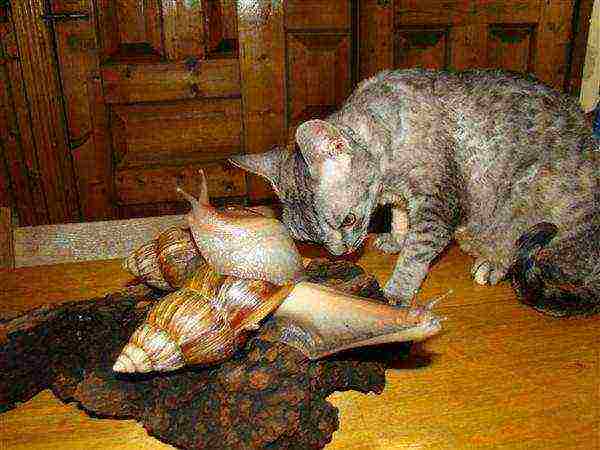
Pet lovers can be divided into two camps. The first days will not live without chasing your pet in the park, without having fun playing with him in the morning, at lunchtime and in the evening. Such owners prefer active animals, splashing out their energy with them. Representatives of the second camp, people who prefer a more relaxed lifestyle, silence and regularity. And if earlier such lovers most often became the owners of fish or turtles, now snails have been added to this list. How to care for Achatina at home, what these snails eat and what are the features of their content, you will learn from our article.
Giant snail Achatina - who is she

Many have observed snails in childhood. While playing near a river or lake, one could meet many of these tiny animals carrying their home. But hardly anyone has managed to meet individuals larger than a walnut.
Achatina live in tropical countries and are the largest of all snail species. During their life cycle, they grow about 10 cm in size, although in nature there are some representatives that have reached a length of 20 or even 30 cm.
They live in many African countries, in Russia due to the peculiarities of the climate they are not found. But, given that these are one of the participants in the top 100 pests of agricultural plants, this is more of a reason for joy. If in the wild Achatina is more likely to bring harm, then as a pet they are very unpretentious, interesting and therefore in demand among exotic lovers.
This mollusk senses smells with the tips of its tentacles, and with its sole it senses the shape of objects, breathes through the skin and does not hear anything at all.
The color of the shell directly depends on what was eaten. Color may vary. A monochromatic color is replaced by a multi-colored pattern and vice versa.
There are about 100 species: common, lemon, brown achatina, fulica and reticulata snails. Since they are all unpretentious, the choice of a pet is rather based on aesthetic criteria, such as the color of the shell and its shape.
Benefits of Achatina snails
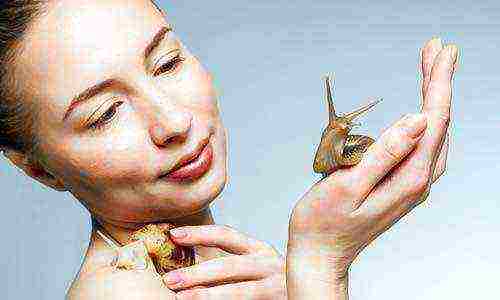
Many owners call these unpretentious creatures ideal pets. Beautiful, but slow and "not talkative" animals please the eye and do not hurt the ear.
These molluscs are capable of hibernating for almost two months. So with them you are not threatened to ask neighbors or relatives to look after the pets during the vacation. You can safely go to the sea or to your grandmother in the village or on a trip across the country. The animal hibernates in the absence of food and the presence of very dry soil in the terrarium, so it is better to start preparing for bed in advance. After returning from a trip, soak your pet under warm water for about 10 minutes and then feed immediately.
It is believed that Achatins are able to remember their owners. They love touching, bathing in warm water. Over time, they can develop reflexes to certain actions of the owner. Despite the fact that their long memory is only about one hour, this achievement cannot but rejoice.
Pets will not cause any damage to your furniture or clothing.
They do not cause allergies and therefore can become friends with an allergic owner without any problems.
Disadvantages of Achatina snails

They are unpretentious in food, which is a plus, but they eat a lot and often, which affects the regularity of their toilet. This means the frequency of cleaning the terrarium. If you do not follow the hygiene of the snails' home, midges and microbes will start there, which will greatly complicate your life.
If you have a light sleep, then you should not have more than one pet of this type. Since these animals are usually activated at night, an unpleasant sound from the friction of several shells will prevent you from falling asleep.
Reproduction in Achatina

One of the biggest drawbacks is reproduction. It is not in vain that the Achatins were included in the list of the main pests of agricultural crops. In just one clutch, they produce up to three hundred eggs, which you will have to remove regularly. Unless you decide to start breeding these slow house bearers. The number of clutches reaches 4-6 per year.
It is rather curious to know how Achatina reproduce. During the first year of the animal's life, the full achievement of puberty occurs. And what is interesting for procreation is that a second partner is not always required. Giant snails are hermaphrodites, that is, they carry both feminine and masculine principles. And in a critical state for the population (a lonely life in an aquarium is also suitable here) individuals are capable of self-fertilization. So even by acquiring only one pet, you run the risk of finding a clutch of eggs. We remind you that even at one time such eggs can be several hundred.
To minimize the laying of eggs, you need to make the thickness of the coating in the dwelling less than 3 cm. This will complicate the process and most likely prevent it.
If you nevertheless noticed eggs in the terrarium and do not want to frantically distribute the offspring to relatives, friends and neighbors in a couple of weeks (this is the period needed for the cubs to hatch), then the following will be required. It will be necessary to collect all the eggs (they are similar in shape to chicken eggs, but the size of one does not exceed 5 mm). The next steps are pretty brutal. Eggs either need to be boiled or frozen. Unfortunately, there is no other way to get rid of the possible offspring of the pet. It is not recommended to just throw away eggs. After all, a hundred hatched can harm the environment, and if each of them gives the same offspring, then a snail apocalypse on your street is inevitable.
In England, there is a special law prohibiting the release of Achatina into the wild due to their destructive love for crops.
How fast do Achatina snails grow and how long do they live?
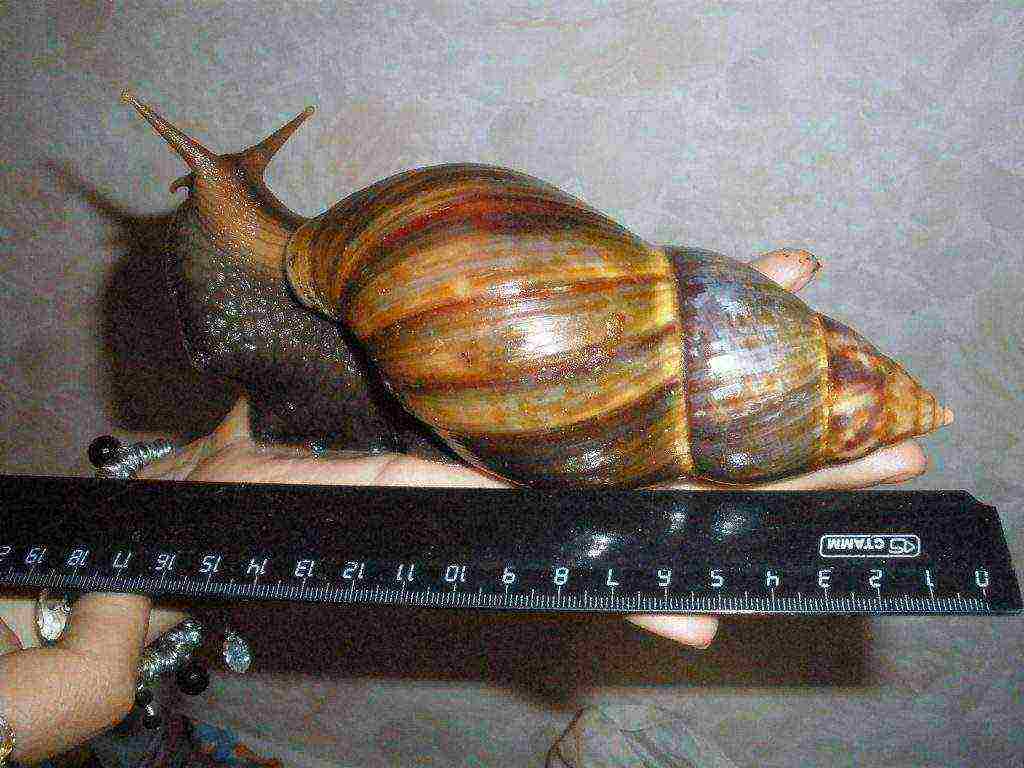
The most active growth rate occurs in the first 2 years of the mollusk's life. The growth process continues throughout life, but slows down significantly over time.
Under the conditions of life in a terrarium, they are able to live about 5-10 years. The better you take care of your pet, the longer it stays with you.
Achatina snail: maintenance and care at home
In order for your pet to feel as comfortable as possible in your house or apartment, take care of the ideal home for him.
Choosing a house
Use a container, aquarium, or terrarium.
One medium-sized snail feels comfortable in a 10 liter container. The larger the pet becomes, the larger the house will have to be purchased for it.
The closer the conditions inside the dwelling resemble those that exist in the wild, the more comfortable the snail will feel.
From above, the container must be protected by a lid.In order for fresh air to enter the house, slightly move the lid or arrange small holes. Moss, fragments of clay pots, poorly rotting wood can be placed on the bottom. Planting a fern or ivy will not be superfluous. This will make your home more comfortable and beautiful. Live plants will also purify the air in the aquarium.
It is not recommended to use sand or peat as a substrate (filler). The walls will be constantly dirty, and the sand also encourages individuals to lay eggs, the shortcomings of which we have already written.
In any case, cleaning the room is required as it gets dirty. This will usually be done once a month or every few months. We are talking about cleaning glass and changing the substrate. It is advisable to remove the waste products of your pet daily. This will not take much time, but it will keep the snail's home clean, and therefore yours.
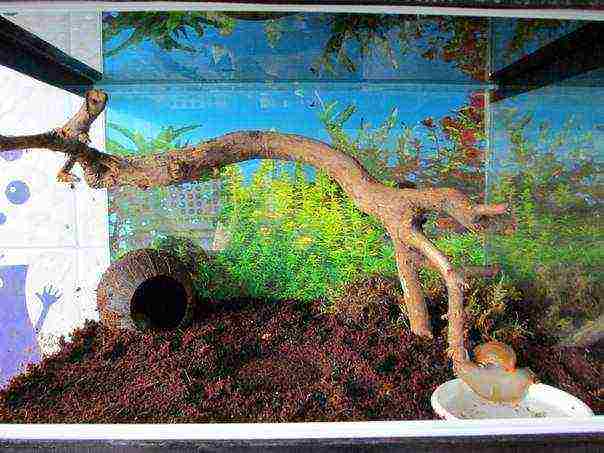
Many owners are beginning to worry about the lighting of the house and even purchase special lamps. In fact, the intensity of the rays does not affect the snails in any way. On the contrary, they lead an active lifestyle in a darkened environment, but when the sun's rays appear, they hide in the substrate.
Nonetheless, the Achatina people from the African continent will need heating lamps. Especially during the harsh Russian winters. You should not install the lamp directly in the terrarium, as snails can begin to crawl on it and get burned. Let it be located in the immediate vicinity of the dwelling, but not inside it. For the same reason, do not set up a terrarium near a battery.
Humidity is another criterion for home improvement. If the pet is hanging on the walls, then this is a sure sign that the humidity is high. To do this, you need to dry the surface by directing the sun's rays inward. With a lack of moisture, the mollusk will hide inside the shell. In this case, use a spray bottle to spray the filler and everything will fall into place.
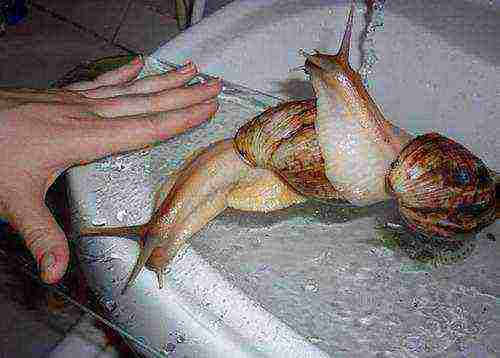
One of my favorite activities is swimming. Be sure to do it under warm water, but under a tap or shower: it doesn't matter. If the pet is uncomfortable, he will hide under the sink. This means that you can change the water pressure or make it a little warmer / colder.
How to feed Achatina snails at home
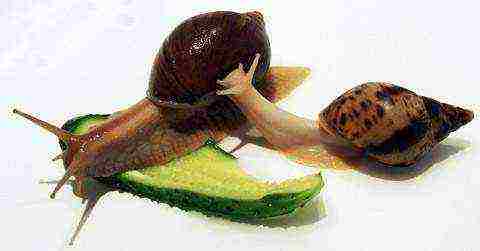
With these pets, you don't have to choose between dry food and table food. Giant snails are voracious creatures and will eat whatever you offer them. Of course, they will give preference to food of plant origin. Moreover, the young prefers fresher plants and the older the individual, the older, even rotten food it prefers. Also, the number of feedings depends on age. Owners feed young animals every day, and adult pets every few days.
The standard diet includes carrots, cabbage, cucumber. But this set should not be limited. Include in the menu:
- greens (clover, dandelion, plantain, nettle, other meadow and field herbs);
- fruits (literally everything that has enough imagination and a wallet, from apples to figs);
- berries;
- vegetables (mushrooms, broccoli, zucchini, spinach, etc.);
- legumes and peas.
In nature, ulits do not hesitate to eat heavier food. Therefore, from time to time you can treat your pet with pieces of boiled meat, eggs or mushrooms.
Like any animal, yours will eventually begin to show a gastronomic interest in some particular types of vegetables or fruits. Pamper your pet with them from time to time.
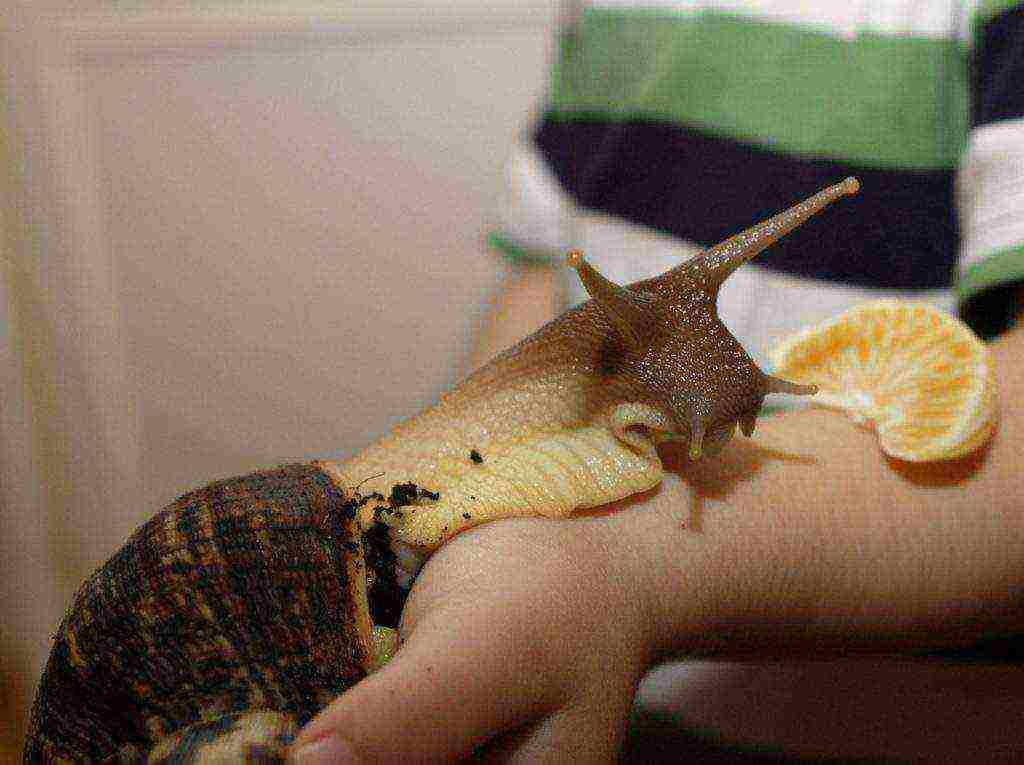
In addition to plants, calcium must be included in the diet of Achatina. This element is a must for the construction of the sink. It can be crushed eggshells, feed chalk, sepia. If there is not enough calcium in the animal's body, then the shell will be soft and easily deformed. Which can lead to its loss over time. And instead of a snail with a beautiful shell, you will have a slug.
Calcium can also be obtained from ready-made mixtures that are sold at pet stores.
Do not forget that along with food, there should always be drinking water in the aquarium. Make sure that the bowl is heavy enough by weight, because if the snail constantly turns it over, then the humidity in the dwelling will be constantly increased.
What to avoid on the menu: fried, smoked, flour, sweet, sour, salty. Saying "No" to such products will be useful for both the pet and the owner.
We draw conclusions: why snails are needed at home
These animals embody sluggishness and passivity in their purest form. You can learn from them to avoid the hustle and bustle and be a little slower, calmer, more detached in the cycle of daily affairs.
This "beast" will be an excellent companion for not the most responsible owners. He will eat almost everything that you cook, fall asleep during your vacation, will not demand to play in the middle of the night and ask to use the toilet in the early morning. Brighten up life without requiring constant attention and care.
Once you get to know the Achatins, you will become friends for years to come.


